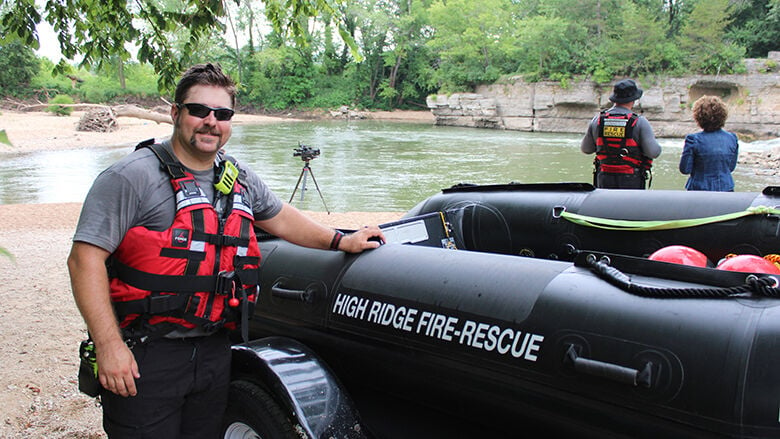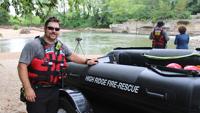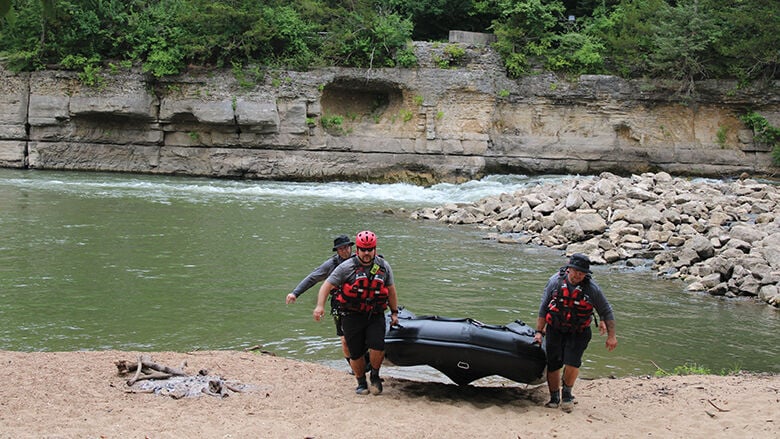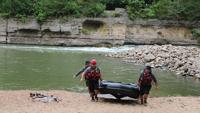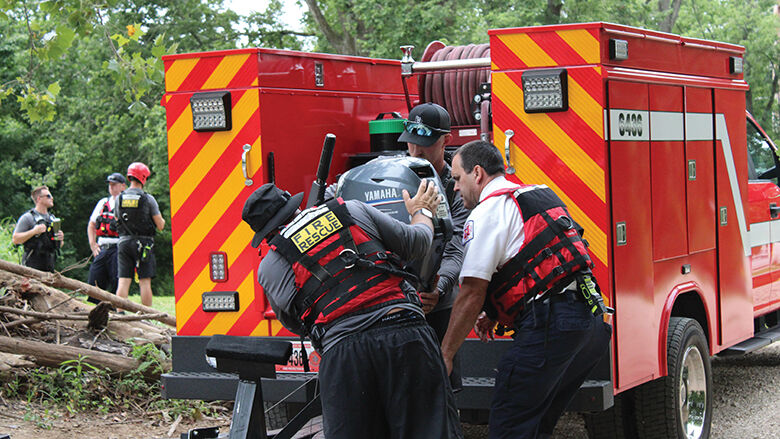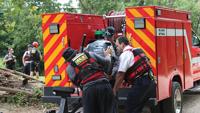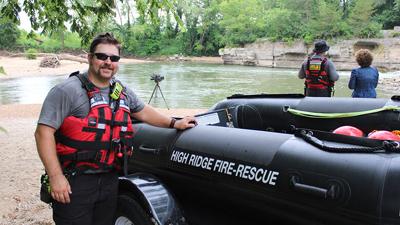The High Ridge Fire Protection District regularly trains for emergency water rescues on the Big River at Rockford Park. Since 2014, seven people have drowned at the park's river access point.
Area firefighters frequently train for emergencies on Jefferson County waterways to keep swimmers, fishers, boaters and everyone else enjoying the water safe.
The High Ridge Fire Protection District covers 52 square miles in northwestern Jefferson County, with both the Meramec and Big Rivers in its coverage area.
The Rock Community Fire Protection District covers 38 square miles in the Arnold, Imperial and Barnhart areas, with both the Meramec and Mississippi rivers in its coverage area.
Big River dangers
Both the High Ridge and Eureka fire protection districts train frequently on the Big River at the Rockford Park access point in House Springs, preparing to rescue swimmers who are either drowning or in distress.
High Ridge Fire Chief John Barton said constant training on the river is crucial to keep his firefighters safe in the event of a rescue. During the warmer summer months, the park is a popular spot for locals and visitors alike to cool off, raising the likelihood of water rescues.
Eureka and High Ridge Fire also respond to emergency calls farther downriver, where the Big River meets the Meramec River in the Jefferson County portion of Eureka. The area is a popular floating route, and both emergency agencies have been called to rescue floaters who have gotten stuck or drifted off course.
On July 18, crews from the two fire districts deployed inflatable and rigid-hull rescue boats on the Big River at Rockford Park to practice three rescue scenarios: lifting a dummy victim pinned by the current and the rock bluffs into an inflatable boat, throwing buoys into the water to observe the patterns of the current, and securing the boats to anchor points in the bluffs, used for stabilization as trapped victims are transported from the bluff face to the boats.
Since 2014, High Ridge Fire has responded to 60 emergencies at Rockford Park, including 31 medical emergencies, ranging from overdoses to heat stroke, and 29 water rescues.
“We have to do what we have to do to protect the public, but our personnel are also being exposed to the same life-threatening risks over and over again,” Barton said. “As a chief of an emergency response agency, I want to try to minimize that as much as possible, and that’s why we’re trying to continually push the message about not swimming out here. Sometimes you wonder if we’re just playing the odds every time we go out there – you put yourself in the same dangerous situation over and over again.”
Barton said seven people have drowned on the river near the park in the last decade, and another three people nearly drowned. Near-drownings are a new classification for the district, he said.
So far this summer, High Ridge Fire has been called to the park four times, once for a water rescue, twice for near-drowning incidents and once for the drowning of a 44-year-old man from Overland.
Barton said High Ridge Fire is working to educate the public about the dangers of swimming at Rockford Park. He strongly advises against it.
The park is owned and operated by Jefferson County. In March 2024, the Jefferson County Council voted to change the name of the park from Rockford Beach to Rockford Park and to ban alcohol and marijuana, in the hopes of preventing future drownings. The council stopped short of outright banning swimming at the access point.
The county installed signs at the park’s river access point last July recommending visitors avoid swimming or wading. The sign also includes symbols showing a person swimming with a red slash through the image.
High Ridge Fire was called to the park eight times the previous summer for water rescues, with one near-drowning and the drowning of Guadalupe Lopez of Madison, Ill.
Strong and swift currents directly downriver of the Rockford Park dam often take swimmers by surprise, dragging them underwater in a whirlpool-like pattern, Barton said.

High Ridge Fire Protection District firefighters carry an inflatable rescue boat back to a trailer for transport at Rockford Park.
Water rescue response
Rockford Park is on the western edge of the High Ridge Fire district and close to the eastern edge of the Eureka Fire district. Because Eureka Fire’s inflatable boat is stored at its station in Hoene Springs and High Ridge Fire’s boat is at its High Ridge station, Eureka Fire crews often respond to water rescues at Rockford Park first, said Eureka Fire Chief Scott Barthelmass.
He said both agencies frequently train together to ensure adequate emergency responses.
“Training is key,” Barthelmass said. “It’s a challenging environment to conduct a rescue. It puts our personnel in grave danger. I think we’ve all tried to get the message to people that this is not a place to swim; it’s not a place to have your family in the water.”
For a water rescue, Barton said High Ridge Fire responds with two inflatable rescue boats, two rigid-hull rescue boats, an ambulance and four firetrucks. More than 20 first responders are usually on the scene. Because water rescues are so resource-heavy, additional area fire districts are called in to cover the rest of the High Ridge Fire district while the emergency is handled.
Eureka Fire has two rigid-hull boats and an inflatable boat in its arsenal.
Firefighter Jacob Boedy said the inflatable boats are equipped with life jackets, helmets and throw bags, which can be used to throw a piece of rope to a drowning victim and pull him or her toward shore or the boat. Boedy has been with High Ridge Fire for nine years.
The lighter inflatable boats can be carried to more remote places along the river, whereas the hard-bottom boats must be put in at a boat ramp, Boedy said.
Barton said fire crews try to get in the water as quickly as possible during an emergency, but they must keep themselves safe.
“We have to go through safety checks, make sure we’ve got all of our equipment ready to go,” he said. “We have to carry the boat down to the water – it takes six people to physically carry the boat the rest of the way from the ramp into the water. You have to put the motor on it, get the motor running and let the motor warm up for a second so it doesn’t stall out when we’re out in the water.
“It’s carefully orchestrated chaos.”
High Ridge Fire’s hard-bottom boat is equipped with sonar instruments, allowing crews to look under the water’s surface, Boedy said.
“When we recover a body (on the Big River at Rockford Park), we’ll bring the hard-bottom boat up there with the 360-degree sonar,” he said. “If you walk 10 feet out, (the current) becomes like a washing machine. It just spins underneath ... That’s where people get in trouble. They’ll get caught, halfway suspended in the water, and they’ll just spin. You’ll see them start spinning, and it makes it hard for us to get them because they’re constantly moving. You gotta be almost perfect to catch them.”
High Ridge Firefighter Matt Miniea, who’s been with High Ridge for 13 years, said “repetition is key” when it comes to training on the Big River. Each scenario is a chance for the crews to observe the ever-changing flow of the water.
“If we come down here 10 times a year and train on the river 10 times, you know, that’s 10 more times that we’ve seen the river,” he said. “We’ve seen how it reacts. We’ve seen where people get stuck and where, unfortunately, people are losing their lives down here. It’s like our Cliff’s Notes. We can go back to the time we were down here, you know, maybe two months ago, and it’s the same conditions above water, so we might be able to get an idea of what it’s like underwater.”

Firefighters Jacob Boedy and Matt Miniea with the High Ridge Fire Protection District, along with Eureka Fire Protection District Chief Scott Barthelmass, put an inflatable boat motor on a trailer.
Rock Fire
Many of the Rock Fire’s water-related responses occur along the Meramec, which is popular for boating, swimming and fishing, said Matthew Ham, the district’s division chief compliance officer.
From 2019 to 2024, Rock Fire responded to 53 water-related incidents, which can range from ice rescues in the winter to swimming or recreational rescues in the summer, Ham said.
“The dynamic nature of the river, such as fluctuating water levels, strong currents and submerged debris, creates hazardous conditions that can lead to the need for emergency responses,” he said. “We don’t discourage the public from enjoying local waterways, but we strongly advise people to understand the risks and take appropriate precautions (including) wearing life jackets at all times on or near the water, never swimming alone, avoiding alcohol use and being aware of weather and current conditions.
“Both the Meramec and Mississippi Rivers can be unpredictable, with strong currents, submerged hazards and rapidly changing conditions.”
Ham said Rock Fire is equipped with two inflatable rescue boats “designed for rapid deployment in shallow and fast-moving water.” The district also has two rigid-hull boats with sonar systems. He said the hard-bottomed boats are better suited for emergencies on the Mississippi River due to the river’s depth and current.
“For general water rescue operations, our crews train on both the Meramec and Mississippi Rivers, utilizing our two inflatable boats and two rigid hull boats, one of which is equipped with a fire pump to support both rescue and suppression efforts,” Ham said. “For more advanced, scenario-based training, our personnel take part in swift water rescue exercises at Six Flags’ Thunder River ride during the spring and fall. This location provides a controlled environment that effectively simulates fast-moving water conditions.
“Additionally, we conduct ice rescue training in local ponds during the winter months to ensure our crews are prepared for cold water emergencies.”
Ham said any personnel operating the district’s rescue boats have specialized boat rescue and swift water technician training.
“This comprehensive training equips them to respond effectively to fast-moving water emergencies and covers essential topics, such as pre-planning, use of personal protective equipment, incident action planning, swift water rescue techniques, advanced rope systems and the integration of boats and helicopters in rescue operations,” he said.



